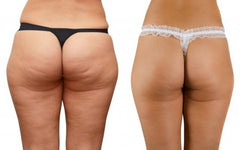The Myths and Facts About Cellulite
Posted on 21 January 2016 by Ning W
Share this post

With beach season in full swing, many women are turning their backs to their mirrors, only to discover that cellulite has crept up and bit them on the proverbial bottom during the winter months when they were covered up. A form of fat that most commonly shows up on the butt, hips and thighs, cellulite is bumpy, lumpy fat that is pushing against the connective tissue above it, causing that tissue to pucker. And for the 70 percent of women that have it – cellulite impacts way more women than men, unfortunately – the condition can be the stuff from which our worst nightmares are made.
What Causes Cellulite
While being overweight can contribute to cellulite, even lean folks can develop it, especially if they skip the gym. In reality, cellulite occurs when your skin isn’t healthy, which means diet, hydration levels and metabolism all play a role in whether or not you develop cottage cheese thighs or not. Other factors include: Genetics: If your mom spent the summer with a towel wrapped around her waist to hide her cellulite and you never saw your grandmother’s thighs, there’s a good chance you’ll develop cellulite, too. According to Health magazine, there’s a genetic test on the market that can give you a heads up as to whether you’re at risk. (It’s not a hard and fast rule, however, and eating right and exercising can put the enemy of swim suit season in its place.) Hormones: Most women will develop cellulite during their golden years, because estrogen plays a key role in blood vessel health. When estrogen levels go down, circulation can be compromised, so less oxygen is being carried to skin cells to keep them healthy. Without the proper fuel, collagen and elastin proteins are slower to regenerate, and the dermis of the skin breaks down. Toxins: While some experts dispute the claim, researcher Yinka Thomas told the Daily Mail that toxins that build up in fatty tissue are the real villains that trigger cellulite. “We're constantly told by general practitioners that cellulite is a genetic problem, but this isn’t true. It’s a problem of lifestyle. We women are subjected to more toxins than ever before - in the food we eat, the air we breathe, even the creams we put on our skin.” Thomas has a point. Free radical activity is caused by pollutants including cigarette smoke and environmental toxins, and they are one of the leading factors in the breakdown of the collagen and elastin that prevent fat cells from poking through the dermis. Flushing toxins from our bodies – through a healthy diet that fights free radical activity as well as skin care products that infuse cells with additional antioxidants – helps fight cellulite on two different levels.
Cellulite Treatment Options
While weight loss and exercise that targets the specific regions where cellulite shows up are the best and most effective ways to erase cellulite for good, there are other treatments that are being touted to help erase cellulite. Here’s the skinny on these fat-reducing claims. Liposuction: Many women mistakenly think that liposuction will help lift away the fat associated with cellulite, but the American Academy of Dermatology tells a different tale. Because lipo removes deep fat – that found beneath the cellulite cells at the top of the skin’s subcutaneous level – it can actually increase the appearance of cellulite by increasing the instability that causes cellulite in the first place. Massage and spa treatments: Massage and other spa treatments boost circulation, which can help improve the health of skin by bringing oxygen to the cells at the skin’s surface. While experts say the effects are only temporary, a spa treatment can inspire you to work harder on your health, which will have a big impact on cellulite over time. Laser treatment: The Food and Drug Administration has approved a laser device that claims to break down bands of collagen that allow fat to dimple through, a one-time treatment that smooths skin instantly. According to those performing the procedure, the results last up to two years, and improve over time. “We believe that if the cellulite has stayed away for two years, it’s probably gone for good,” Dr. Bruce Katz, director of the Juva Skin and Laser Center in New York City, told Fox News.
Do cellulite creams work?
While most experts say that creams won’t help reduce the appearance of cellulite, they’re not looking at the big picture. Cellulite shows itself because the dermis – the layer of skin where collagen and elastin are – is not as strong as it could be, and the collagen and elastin fibers have become weaker. By encouraging the production of higher levels of collagen and elastin, cellulite creams can absolutely reduce cellulite in the long-term. And there can also be immediate effects, especially when using a product that contains caffeine. Caffeine helps constrict blood vessels, temporarily reducing blood flow so skin appears tightened and more toned. Caffeine essentially smooths out the bumps and lumps, and although the benefits are temporary, when combined with more lasting treatments, can make a difference.
Best Cellulite Cream
So what products should you look for when searching for a cellulite cream that works? First, be sure to select a cream that features natural ingredients. Many contain aminophylline, a prescription drug used in the treatment of asthma that can trigger allergic reactions. To zap cellulite faster, Senvie’s all-natural Celluvin helps reduce the appearance of cellulite with power-packed ingredients including collagen to help improve the look of skin and retinol to help regenerate collagen and elastin, reducing the appearance of the dreaded dimples. Caffeine: As a stimulant, the caffeine in coffee dilates blood vessels, which temporarily tones and tightens tissue. Plus it increases circulation and reduces water retention, both of which may also help smooth the rumpled look of cellulite. Rose hip seed oil: Packed with antioxidants including vitamins A and C, rose hip seed oil can help strengthen and rebuild connective tissues such as collagen and elastin, strengthening the dermis so the dimpling and puckering of cellulite is diminished. Dimethicone: A member of the silicone family, dimethicone helps seal in healing ingredients by forming a protective barrier over the skin’s surface. This traps in the good stuff – antioxidants, moisturizers and botanicals – so they can go to work rebuilding and restoring your skin, one cell at a time.



0 comments